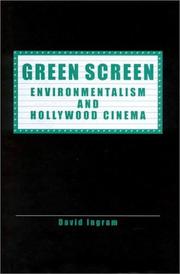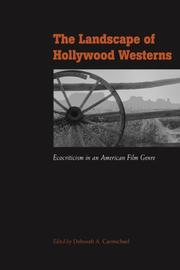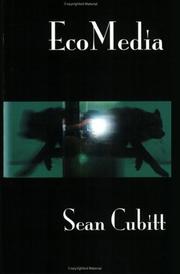| Listing 1 - 10 of 30 | << page >> |
Sort by
|

ISBN: 0859896080 Year: 2000 Publisher: Exeter University of Exeter Press
Abstract | Keywords | Export | Availability | Bookmark
 Loading...
Loading...Choose an application
- Reference Manager
- EndNote
- RefWorks (Direct export to RefWorks)

ISBN: 9780874808667 0874808669 Year: 2006 Publisher: Salt Lake City (Utah) : University of Utah press,
Abstract | Keywords | Export | Availability | Bookmark
 Loading...
Loading...Choose an application
- Reference Manager
- EndNote
- RefWorks (Direct export to RefWorks)
Nature in motion pictures. --- Western films --- History and criticism

ISBN: 9789004454910 9789042018853 Year: 2005 Publisher: Leiden; Boston : BRILL
Abstract | Keywords | Export | Availability | Bookmark
 Loading...
Loading...Choose an application
- Reference Manager
- EndNote
- RefWorks (Direct export to RefWorks)
For the last twenty years ecology, the last great political movement of the 20th century, has fired the imaginations not only of political activists but of popular movements throughout the industrialised world. EcoMedia is an enquiry into the popular mediations of environmental concerns in popular film and television since the 1980s. Arranged in a series of case studies on bio-security, relationships with animals, bioethics and biological sciences, over-fishing, eco-terrorism, genetic modification and global warming, EcoMedia offers close readings of Peter Jackson's The Lord of the Rings , Miyazake's Princess Mononoke , The Perfect Storm , X-Men and X2 , The Day After Tomorrow and the BBC's drama Edge of Darkness and documentary The Blue Planet. Drawing on the thinking of Flusser, Luhmann, Latour, Agamben and Bookchin, EcoMedia discusses issues from whether animals can draw and why we like to draw animals, to how narrative films can imagine global processes, and whether wonder is still an ethical pleasure. Building on the thesis that popular film and television can tell us a great deal about the state of contemporary beliefs and anxieties, the book builds towards an argument that the polis , the human world, cannot survive without a three way partnership with physis and techne , the green world and the technological.
Mass media and the environment --- Nature in motion pictures
Book
ISBN: 9780415894128 0415894123 9780203583906 0203583906 Year: 2013 Publisher: New York : Routledge,
Abstract | Keywords | Export | Availability | Bookmark
 Loading...
Loading...Choose an application
- Reference Manager
- EndNote
- RefWorks (Direct export to RefWorks)
How do cinematic portrayals of the weather reflect and affect our experience of the world? While weatherly predictability and surprise can impact our daily experience, the history of cinema attests to the stylistic and narrative significance of snow, rain, wind, sunshine, clouds, and skies. Through analysis of films ranging from The Wizard of Oz to The Umbrellas of Cherbourg, from Citizen Kane to In the Mood for Love, Kristi McKim calls our attention to the ways that we read our atmospheres both within and beyond the movies. Building upon meteorological definitions of weather's dynamism and volatility, this book shows how film weather can reveal character interiority, accelerate plot development, inspire stylistic innovation, comprise a momentary attraction, convey the passage of time, and idealize the world at its greatest meaning-making capacity (unlike our weather, film weather always happens on time, whether for tumultuous, romantic, violent, suspenseful, or melodramatic ends). Akin to cinema's structuring of ephemera, cinematic weather suggests aesthetic control over what is fleeting, contingent, wildly environmental, and beyond human capacity to tame. This first book-length study of such a meteorological and cinematic affinity casts film weather as a means of artfully and mechanically conquering contingency through contingency, of taming weather through a medium itself ephemeral and enduring. Using film theory, history, formalist/phenomenological analysis, and eco-criticism, this book casts cinema as weather, insofar as our skies and screens become readable through our interpretation of changing phenomena.
Book
ISBN: 1441603689 9781441603685 0791477177 9780791477175 9780791476772 0791476774 9780791476789 0791476782 Year: 2009 Publisher: Albany SUNY Press
Abstract | Keywords | Export | Availability | Bookmark
 Loading...
Loading...Choose an application
- Reference Manager
- EndNote
- RefWorks (Direct export to RefWorks)
"Ecology and Popular Film examines representations of nature in mainstream film while also looking at film itself as a form of nature writing. Considering a selection of mainstream movies that embrace a wide variety of environmental themes, Robin L. Murray and Joseph K. Heumann explore such themes as environmental politics, eco-terrorism, ecology and home, tragic and comic eco-heroes, the spectacular, and evolutionary narrative, in a manner that is both accessible and fun. The book also includes a comprehensive filmography of films that deal with environmental themes and issues."--BOOK JACKET.
Natur
Book
ISBN: 9781501381324 Year: 2023 Publisher: London : Bloomsbury,
Abstract | Keywords | Export | Availability | Bookmark
 Loading...
Loading...Choose an application
- Reference Manager
- EndNote
- RefWorks (Direct export to RefWorks)
Limit Cinema explores how contemporary global cinema represents the relationship between humans and nature. During the 21st century this relationship has become increasingly fraught due to proliferating social and environmental crises; recent films from Lars von Trier's Melancholia (2011) to Apichatpong Weerasethakul's Uncle Boonmee Who Can Recall His Past Lives (2010) address these problems by reflecting or renegotiating the terms of our engagement with the natural world. In this spirit, this book proposes a new film philosophy for the Anthropocene. It argues that certain contemporary films attempt to transgress the limits of human experience, and that such 'limit cinema' has the potential to help us rethink our relationship with nature. Posing a new and timely alternative to the process philosophies that have become orthodox in the fields of film philosophy and ecocriticism, Limit Cinema revitalizes the philosophy of Georges Bataille and puts forward a new reading of his notion of transgression in the context of our current environmental crisis.To that end, Limit Cinema brings Bataille into conversation with more recent discussions in the humanities that seek less anthropocentric modes of thought, including posthumanism, speculative realism, and other theories associated with the nonhuman turn. The problems at stake are global in scale, and the book therefore engages with cinema from a range of national and cultural contexts. From Ben Wheatley's psychological thrillers to Nettie Wild's eco-documentaries, limit cinema pushes against the boundaries of thought and encourages an ethical engagement with perspectives beyond the human.
Motion pictures --- Motion pictures --- Nature --- Nature in motion pictures --- Philosophy. --- Social aspects. --- Effect of human beings on.
Book
ISBN: 1350194980 9781350194984 Year: 2022 Publisher: London Bloomsbury Academic
Abstract | Keywords | Export | Availability | Bookmark
 Loading...
Loading...Choose an application
- Reference Manager
- EndNote
- RefWorks (Direct export to RefWorks)
"The Art of Czech Animation is the first comprehensive English language account of Czech animation from the 1920s to the present, covering both 2D animation forms and CGI, with a focus upon the stop-motion films of Jirí Trnka, Hermína Týrlová, Jan Švankmajer and Jirí Barta. Stop-motion is a highly embodied form of animation and The Art of Czech Animation develops a new materialist approach to studying these films. Instead of imposing top-down Film Theory onto its case studies, the book's analysis is built up from close readings of the films themselves, with particular attention given to their non-human objects. In a time of environmental crisis, the unique way Czech animated films use allegory to de-centre the human world and give a voice to non-human aspects of the natural world points us towards a means by which culture can increase ecological awareness in viewers. Such a refutation of a human-centred view of the world was contrary to communist orthodoxy and it remains so under late-stage consumer-capitalism. As such, these films do not only offer beautiful examples of allegory, but stand as models of political dissent. The Art of Czech Animation is a unique endeavour of film philosophy to provide a materialist appraisal of a heretofore neglected strand of Central-Eastern European cinema."--
Animated films --- Animated films --- Animals in motion pictures --- Nature in motion pictures --- History and criticism --- Political aspects
Book
ISBN: 0803294905 0803294921 9780803294905 9780803294912 0803294913 9780803294929 9780803285699 0803285698 Year: 2016 Publisher: Lincoln
Abstract | Keywords | Export | Availability | Bookmark
 Loading...
Loading...Choose an application
- Reference Manager
- EndNote
- RefWorks (Direct export to RefWorks)
Book
ISBN: 9781350104594 Year: 2020 Publisher: London : Bloomsbury Publishing,
Abstract | Keywords | Export | Availability | Bookmark
 Loading...
Loading...Choose an application
- Reference Manager
- EndNote
- RefWorks (Direct export to RefWorks)
The Art of Czech Animation is the first comprehensive English language account of Czech animation from the 1920s to the present, covering both 2D animation forms and CGI, with a focus upon the stop-motion films of Jirí Trnka, Hermína Týrlová, Jan Švankmajer and Jirí Barta.Stop-motion is a highly embodied form of animation and The Art of Czech Animation develops a new materialist approach to studying these films. Instead of imposing top-down Film Theory onto its case studies, the book's analysis is built up from close readings of the films themselves, with particular attention given to their non-human objects.In a time of environmental crisis, the unique way Czech animated films use allegory to de-centre the human world and give a voice to non-human aspects of the natural world points us towards a means by which culture can increase ecological awareness in viewers.Such a refutation of a human-centred view of the world was contrary to communist orthodoxy and it remains so under late-stage consumer-capitalism. As such, these films do not only offer beautiful examples of allegory, but stand as models of political dissent. The Art of Czech Animation is a unique endeavour of film philosophy to provide a materialist appraisal of a heretofore neglected strand of Central-Eastern European cinema.
Animated films --- Stop-motion animation films --- Animals in motion pictures --- Nature in motion pictures --- History and criticism. --- Political aspects --- Films d'animation
Book
ISBN: 9789042036130 9789401208840 9401208840 9042036133 Year: 2012 Volume: 39 Publisher: Amsterdam Rodopi
Abstract | Keywords | Export | Availability | Bookmark
 Loading...
Loading...Choose an application
- Reference Manager
- EndNote
- RefWorks (Direct export to RefWorks)
Volume 39 of FLS French Literature Series features ten articles on the topic of the environment in French and Francophone Literature and Film. Contributors engage with the work of such authors, filmakers and cartoonists as Michel Serres, Luc Ferry, Patrice Nganang, Marie Darrieussecq, Yann-Arthus Bertrand and Plantu, and such topics as human zoos, eco-colonialism, queer theory, and the environmental catastrophes of WWI and, globally, of human civilization as recorded in the recent eco-documentary, HOME . Wide-ranging, provocative and topical these articles both broaden and deepen the efficacy of ecocriticism as a tool for enriching our understanding of the field beyond the English and American “nature writing” at the theory’s core.
Thematology --- French literature --- Film --- Nature in literature --- Nature in motion pictures --- Ecocriticism --- Motion pictures, French --- Ecocriticism. --- French literature. --- Motion pictures, French. --- Nature in literature. --- Nature in motion pictures. --- Motion pictures --- Nature in poetry --- French motion pictures --- Foreign films --- Ecological literary criticism --- Environmental literary criticism --- Criticism --- History and criticism --- Environmentalism in literature. --- Environmental films.
| Listing 1 - 10 of 30 | << page >> |
Sort by
|

 Search
Search Feedback
Feedback About UniCat
About UniCat  Help
Help News
News